Papers by Yukikazu Takeoka
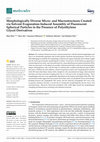
Molecules, 2021
The creation of fluorescent micro- and macrostructures with the desired morphologies and sizes is... more The creation of fluorescent micro- and macrostructures with the desired morphologies and sizes is of considerable importance due to their intrinsic functions and performance. However, it is still challenging to modulate the morphology of fluorescent organic materials and to obtain insight into the factors governing the morphological evolution. We present a facile bottom-up approach to constructing diverse micro- and macrostructures by connecting fluorescent spherical particles (SPs), which are generated via the spherical assembly of photoisomerizable azobenzene-based propeller-shaped chromophores, only with the help of commercially available polyethylene glycol (PEG) derivatives. Without any extra additives, solvent evaporation created a slow morphological evolution of the SPs from short linear chains (with a length of a few micrometers) to larger, interconnected networks and sheet structures (ranging from tens to >100 µm) at the air–liquid interface. Their morphologies and sizes...
Carbon Trends, 2021
This is a PDF file of an article that has undergone enhancements after acceptance, such as the ad... more This is a PDF file of an article that has undergone enhancements after acceptance, such as the addition of a cover page and metadata, and formatting for readability, but it is not yet the definitive version of record. This version will undergo additional copyediting, typesetting and review before it is published in its final form, but we are providing this version to give early visibility of the article. Please note that, during the production process, errors may be discovered which could affect the content, and all legal disclaimers that apply to the journal pertain.
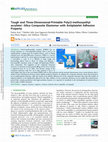
Poly(2-methoxyethyl acrylate) (PMEA) has attracted attention as a biocompatible polymer that is u... more Poly(2-methoxyethyl acrylate) (PMEA) has attracted attention as a biocompatible polymer that is used as an antithrombotic coating agent for medical devices, such as during artificial heart and lung fabrication. However, PMEA is a viscous liquid polymer with low T g , and its physical strength is poor even if a cross-linker is used, so it is difficult to make tough and freestanding objects from it. Here, we design and fabricate a biocompatible elastomer made of tough, self-supporting PMEA− silica composites. The toughness of the composite elastomer increases as a function of silica particle filling, and its stress at break is improved from 0.3 to 6.7 MPa. The fracture energy of the composite elastomer with 39.5 vol % silica particles is up to 15 times higher than that of the cross-linked PMEA with no silica particles and the material demonstrates stress−strain behavior that is similar to that of biological soft tissue, which exhibits nonlinear elasticity. In addition, the composite elastomer shows the potential to be an antithrombotic property, while the results of the platelet adhesion test of the composite elastomer show that the number of adhered platelets is not significantly affected by the silica addition. As the composite elastomer can be rapidly three-dimensionalprinted into complex geometries with high-resolution features, it is expected to contribute to the development of medical devices from readily available materials.
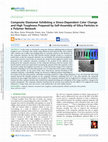
In this study, we developed a composite elastomer exhibiting both mechanical toughness and a stru... more In this study, we developed a composite elastomer exhibiting both mechanical toughness and a structural color change using submicron-sized spherical fine silica particles with a uniform size as fillers and arranging them in a periodic structure in the elastomer. In this composite elastomer, the fine silica particles formed colloidal crystals in a nonclosestpacked state, so that the composite elastomer was very flexible. We showed the possibility for use as strain and stress sensors that can measure the amount of strain applied to and the stress generated in the composite elastomer according to the position of the reflection peak produced by the composite elastomer. In this composite elastomer, both the fracture stress and the fracture strain were improved by increasing the amount of fine silica particles so that the fracture energy and toughness increased. As a result, the fracture energy of the composite elastomer containing 35 vol % fine silica particles was 13.5 times that of the system containing no fine silica particles. In the stress−strain curve observed by uniaxial stretching of this composite elastomer, a shoulderlike change was observed at different positions depending on the content of the fine silica particles, and further stretching resulted in a large energy dissipation. It was also found that after being strained beyond the shoulder position for the composite elastomer containing 44.9 vol % fine silica particles, the composite elastomer became tougher than before it was stretched. This composite elastomer may be toughened by a change in the interaction between the silica−polymer interface that resulted from uniaxial stretching and a dissipation of the energy caused by a change in the particle arrangement. The composite elastomer developed by the present novel method has the ability to be toughened by being subjected to a large strain once and can be a safe material that can avoid sudden fracture.
ACS Materials Letters, 2020
RSC Advances, 2018
Structurally colored coatings with and without iridescence can be fabricated by varying pH of coa... more Structurally colored coatings with and without iridescence can be fabricated by varying pH of coating sols for cathodic electrophoretic deposition.
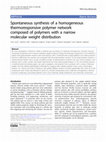
NPG Asia Materials, 2018
We have developed a method to obtain a polymer gel consisting of a relatively homogeneous network... more We have developed a method to obtain a polymer gel consisting of a relatively homogeneous network structure composed of polymers with a narrow molecular weight simply by mixing the necessary compounds. In this method, a radical chain polymerization reaction with a fast reaction rate is combined with a radical addition cross-linking reaction that has a sufficiently slow reaction rate compared with the polymerization reaction. For the polymerization reaction, a multifunctional initiator with a strictly controlled number of polymerization initiation sites was used to prepare a star polymer with a chain number and length determined by living radical polymerization. In the cross-linking reaction, a multifunctional terminating agent was used to prepare a star polymer from a polymer with a narrow molecular weight via living radical polymerization followed by coupling with multiple polymer chains using a termination reaction. As a result, two kinds of reactions with greatly different kinetics occurred sequentially only when all of the compounds were mixed and allowed to stand at a constant temperature, and a relatively homogeneous network structure comprising cross-linked polymers with a low molecular weight distribution was inherently constructed.
Hosokawa Powder Technology Foundation ANNUAL REPORT, 2016
Generally, we have an image that the structural colored material changes its hue depending on the... more Generally, we have an image that the structural colored material changes its hue depending on the direction of light irradiation and the viewing direction. I found that structural colored materials of various hues without angle dependence could be prepared from white and black materials. As a material, silica, titanium oxide, magnetite, and polymers can be used. We can obtain non-toxic and non-fading color materials at low cost
Polymer Journal, 2016
Herein, I review the fabrication of new optical composites that exhibit color changes without dye... more Herein, I review the fabrication of new optical composites that exhibit color changes without dyes or pigments covering the whole visible region in response to temperature via changes in both the diffraction properties and the wavelength dispersion of their refractive indices. These systems, which are composed of porous polymer membranes and thermosensitive liquids, display bright coloration caused by the Christiansen effect because the wavelength dispersion of the polymer membranes and the liquids intersect in the visible region. The thermally tunable coloration of the porous polymer membranes containing thermosensitive liquid arises from the coincidence at one wavelength of the dispersion curves of the porous polymer membranes and the thermosensitive liquid portions and depends on the composition and temperature of the thermosensitive liquid.
Journal of Materials Chemistry C, 2015
We report a facile strategy for constructing diverse nano/microstructured morphologies via self-a... more We report a facile strategy for constructing diverse nano/microstructured morphologies via self-assembly and phase separation of trigonal azobenzene chromophores showing AIEE in polymer matrices.
Angewandte Chemie (International ed. in English), Jan 14, 2015
We report the preparation of thermally tunable hydrogels displaying angle-independent structural ... more We report the preparation of thermally tunable hydrogels displaying angle-independent structural colors. The porous structures were formed with short-range order using colloidal amorphous array templates and a small amount of carbon black (CB). The resultant porous hydrogels prepared using colloidal amorphous arrays without CB appeared white, whereas the hydrogels with CB revealed bright structural colors. The brightly colored hydrogels rapidly changed hues in a reversible manner, and the hues varied widely depending on the water temperature. Moreover, the structural colors were angle-independent under diffusive lighting because of the isotropic nanostructure generated from the colloidal amorphous arrays.
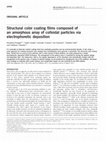
NPG Asia Materials, 2017
It is desirable to fabricate colorful coatings that have nonfading properties and are environment... more It is desirable to fabricate colorful coatings that have nonfading properties and are environmentally friendly. In this study, a novel approach for creating structural color coatings from monodisperse silica particles is presented. The structural color coating films, formed from an array of silica particles with a small amount of black additive, are easily prepared by a simple electrophoretic deposition (EPD) technique. The arrangement of the particle array is controlled by varying the applied voltage and deposition time. The iridescence, that is, the angular dependence, of the structural color dramatically changes with the arrangement of the particle array. A variety of colored coatings can be produced by changing the size of the particles. Structural color coatings on materials with curved surfaces and complicated shapes are also achieved by the EPD method.
Chemical Communications, 2016
This work investigates the influence of the molecular weight of polyrotaxane (PR) cross-linkers o... more This work investigates the influence of the molecular weight of polyrotaxane (PR) cross-linkers on the extensibility of polymer gels.
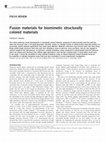
Polymer Journal, 2014
This review addresses recent developments in structurally colored materials composed of submicrom... more This review addresses recent developments in structurally colored materials composed of submicrometer-sized fine particles, where the structural color is not angle-dependent. Recently, studies on colloidal crystals of submicrometer-sized fine particles for structurally colored materials applications have drawn great attention. Materials researchers have become aware that many living things exhibit bright structural colors that arise from amorphous arrays of particles, pores and fibers, and are now engaged in research related to this phenomenon. In particular, colloidal amorphous arrays composed of submicrometer-sized fine particles, which can display vivid structural color without angle dependence, have become a popular topic of study within recent years. In this paper, I review the possibility of using colloidal amorphous arrays as stimuli-responsive colored materials based on the properties of colloidal amorphous arrays that have been elucidated in recent experimental investigations.
Journal of Photopolymer Science and Technology, 2009

ASME 2010 8th International Fuel Cell Science, Engineering and Technology Conference: Volume 2, 2010
Bipolar plates account for about 80% of the fuel cell stack weight. The use of low density and hi... more Bipolar plates account for about 80% of the fuel cell stack weight. The use of low density and high strength conductive composites for making bipolar plates will result in a lighter and more compact fuel cell stack assembly. Light weight composites were developed based on a two component elastomeric silicone RTV matrix. However, two shortcomings of this composite material are low mechanical strength and relatively high permeability to gases. The purpose of this paper is to develop a new composite material which will overcome high permeability and low strength issues through the use of elastomer-plastic blends as the composite matrix. The elastomer-plastic blends consist of vinyl ester with either urethane elastomer or ethylene-propylene-diene (EPDM) rubber. The chosen elastomers have higher tensile strength and lower gas permeability than silicone rubber. The elastomers will be blended with vinyl ester thermoset plastic to further enhance these characteristics. Synergistic conductiv...
The use of general descriptive names, registered names, trademarks, service marks, etc. in this p... more The use of general descriptive names, registered names, trademarks, service marks, etc. in this publication does not imply, even in the absence of a specific statement, that such names are exempt from the relevant protective laws and regulations and therefore free for general use. While the advice and information in this book are believed to be true and accurate at the date of publication, neither the authors nor the editors nor the publisher can accept any legal responsibility for any errors or omissions that may be made. The publisher makes no warranty, express or implied, with respect to the material contained herein.











Uploads
Papers by Yukikazu Takeoka